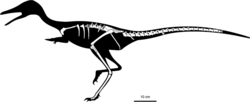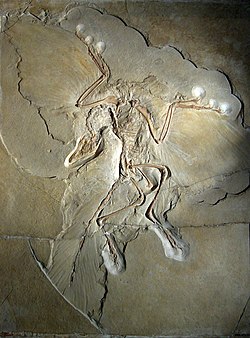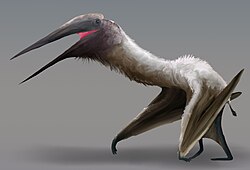Pseudosuchians
New pseudosuchian taxa
| Name | Novelty | Status | Authors | Age | Type locality | Country | Notes | Images |
|---|---|---|---|---|---|---|---|---|
Gen. et sp. nov | Valid | Souza-Filho et al. | Late Miocene | A caiman. Genus includes new species A. pachytemporalis. | ||||
Gen. et sp. nov | Valid | Venczel & Codrea | A Theriosuchus -like crocodyliform. Genus includes new species A. ghirai. | |||||
Gen. nov | Valid | Martin et al. | A member of Crocodyloidea of uncertain phylogenetic placement. Genus includes the species A. bugtiensis. |  | ||||
Gen. et sp. nov | Valid | Coria et al. | A peirosaurid crocodyliform. Genus includes new species B. neuquenianus. Announced in 2018; the final version of the article naming it was published in 2019. | |||||
Gen. et comb. nov | Valid | Foffa et al. | A teleosaurid thalattosuchian. The type species is "Teleosaurus" megarhinus Hulke (1871). |  | ||||
Gen. et sp. nov | Valid | Lamanna et al. | Late Cretaceous (Campanian–?early Maastrichtian) | A peirosaurid crocodyliform. The type species is C. lunai. | ||||
Gen. et sp. nov | Valid | Martínez, Alcober & Pol | A protosuchid crocodyliform. Genus includes new species C. abelini. | |||||
Sp. nov | Valid | Sachs et al. | A new species of the metriorhynchid Cricosaurus from southern Germany, known from a nearly complete skeleton. |  | ||||
Gen. et comb. nov | Valid | Johnson, Young & Brusatte | A relative of Steneosaurus heberti; a new genus for "Teleosaurus" larteti Eudes-Deslongchamps (1866). |  | ||||
Sp. nov | Valid | Arribas et al. | A member of the family Goniopholididae. | |||||
Gen. et sp. nov | Valid | Martin et al. | Probably Middle or Late Jurassic | A member of the family Teleosauridae. Genus includes new species I. potamosiamensis. |  | |||
Sp. nov | Disputed | Hart et al. | Hart (2020) considered it to be likely a junior subjective synonym of the species Isisfordia selaslophensis (Etheridge, 1917), but was unable to determine this with certainty, as both taxa are currently represented by non-overlapping fossil material. [13] |  | ||||
Gen. et sp. nov | Valid | Li, Wu & Rufolo | Originally described as a member of Crocodyloidea, but now treated as a member of Orientalosuchina. Genus includes new species J. nankangensis. Announced in 2018; the final version of the article naming it was published in 2019. |  | ||||
Gen. et sp. nov | Valid | Aiglstorfer, Havlik & Herrera | A non-metriorhynchid metriorhynchoid crocodyliform. Genus includes new species O. meieri. | |||||
Gen. et sp. nov | Valid | Massonne et al. | Eocene (late Bartonian to Priabonian) | A member of the family Alligatoridae. The type species is O. naduongensis. |  | |||
Gen. et sp. nov | Valid | Noto et al. | A crocodyliform belonging to the family Paralligatoridae. Genus includes new species S. sahlsteini. | |||||
Gen. et sp. nov | Valid | Adams | A crocodyliform belonging to the family Paralligatoridae. Genus includes new species T. winkleri. | |||||
Gen. et comb. nov | Valid | Johnson, Young & Brusatte | A basal member of the tribe Machimosaurini; a new genus for "Teleosaurus" boutilieri Eudes-Deslongchamps (1868). |  | ||||
Pseudosuchian research
- A study on the bone histology of Coahomasuchus chathamensis, and on its implications for inferring ontogeny and growth strategy of this species, is published by Hoffman, Heckert & Zanno (2019). [19]
- Tolchard et al. (2019) revise fragmentary archosaurian remains from the latest Triassic lower Elliot Formation (South Africa), interpreting them as fossils of at least two distinct taxa of "rauisuchians", thus representing the southernmost palaeolatitudes that these animals are known to have occurred, their first definitive remains from southern Africa, and some of the most recent records of members of this grade. [20]
- A study on the anatomy of the skeleton of Poposaurus gracilis is published online by Schachner et al. (2019). [21]
- A study on the age of sandstones of the Badong Formation preserving fossils of Lotosaurus adentus is published by Wang et al. (2019). [22]
- Description of the anatomy of the skull of a new specimen of Prestosuchus chiniquensis from the Dinodontosaurus Assemblage Zone of the Pinheiros-Chiniquá Sequence, Santa Maria Super sequence (Brazil) is published by Mastrantonio et al. (2019), who also present the first description of a rauisuchian cranial endocast. [23]
- A study on habitat shifts during the evolutionary history of Crocodylomorpha is published by Wilberg, Turner & Brochu (2019). [24]
- A study on patterns of body size evolution of crocodylomorphs is published by Godoy et al. (2019). [25]
- A study on the quality of the fossil record of non-marine crocodylomorphs is published by Mannion et al. (2019). [26]
- A study on the evolution of skull shape in crocodylomorphs is published online by Godoy (2019). [27]
- A study on the diversity of feeding ecologies of Mesozoic crocodyliforms is published by Melstrom & Irmis (2019). [28]
- A study on patterns of crocodyliform snout shape, on their inferred diet and on the relationship between form and function of crocodyliform skull shape throughout the evolutionary history of this group is published online by Drumheller & Wilberg (2019). [29]
- New fossil material (an isolated left dentary) of Orthosuchus stormbergi is described from the Upper Elliot Formation (South Africa) by Dollman, Viglietti & Choiniere (2019), who also examine the stratigraphic positions of all valid crocodylomorph specimens from the main Karoo Basin. [30]
- Teleosaurid and metriorhynchid teeth are described from, respectively, the Middle Jurassic (Aalenian) and Upper Jurassic (Tithonian) of Slovakia by Čerňanský et al. (2019), representing the first record of members of both families from the country. [31]
- Partial skeleton of a teleosauroid crocodylomorph, representing the most recent record of a definitive non-machimosaurin teleosauroid in Africa reported so far, is described from the Callovian of Tunisia by Dridi & Johnson (2019). [32]
- Fossils of a member of Teleosauroidea with an estimated body length of 9.6 m, representing the most recent definitive record of Teleosauroidea reported so far, are described from the Lower Cretaceous (upper Barremian) Paja Formation (Colombia) by Cortes et al. (2019). [33]
- Redescription of the holotype specimens of Mystriosaurus laurillardi and "Steneosaurus" brevior and a study on the taxonomic validity and phylogenetic relationships of these species is published by Sachs et al. (2019). [34]
- A study on the anatomy and phylogenetic relationships of metriorhynchoids from the Jurassic Rosso Ammonitico Veronese Formation (Italy) is published by Cau (2019), who provides a revised diagnosis of Neptunidraco ammoniticus. [35]
- A three-dimensionally preserved occiput of a member of the genus Torvoneustes , indicating that members of this genus reached larger body sizes than previously supposed, is described from the Upper Jurassic Kimmeridge Clay Formation (United Kingdom) by Young et al. (2019). [36]
- A study on teeth morphology and tooth enamel microstructure in Mariliasuchus amarali is published by Augusta & Zaher (2019). [37]
- A study on the arrangement and morphology of the osteoderms of baurusuchids is published by Montefeltro (2019). [38]
- A study on the anatomy of the pterygoid region and skull airways of Caipirasuchus paulistanus and C. montealtensis is published online by Dias et al. (2019), who report possible anatomical evidence of vocal capacity of C. montealtensis. [39]
- Description of fossils and possible gastroliths of a large-bodied sphagesaurid from the Upper Cretaceous Adamantina Formation (Brazil) is published online by Cunha et al. (2019). [40]
- Description of new fossil material of Pepesuchus from the Upper Cretaceous Adamantina Formation (Brazil) and a study on the phylogenetic relationships of this taxon is published by Geroto & Bertini (2019). [41]
- A study on the diagenesis of fossils of Montealtosuchus arrudacamposi from the Upper Cretaceous Adamantina Formation is published by Marchetti et al. (2019). [42]
- A study on the phylogenetic relationships of members of Neosuchia and on the evolution of longirostry in this group is published online by Groh et al. (2019). [43]
- A study on the taxonomic status and phylogenetic relationships of Sarcosuchus hartti is published online by Souza et al. (2019). [44]
- Partial dyrosaurid skeleton discovered in the 1930s in Paleocene (Danian) strata along the Atlantic coast of Senegal is described by Martin, Sarr & Hautier (2019). [45]
- Description of new dyrosaurid specimens from the Late Cretaceous–early Paleogene of New Jersey (United States), and a study on their implications for the validity of the species Hyposaurus rogersii, is published online by Souza et al. (2019). [46]
- Revision of the large-sized neosuchians Kansajsuchus and " Turanosuchus " from the Late Cretaceous of Central Asia is published by Kuzmin et al. (2019), who interpret Kansajsuchus as a member of Paralligatoridae, and consider Turanosuchus aralensis to be a member of the genus Kansajsuchus belonging or related to the species K. extensus. [47]
- A study on the inner cavities of the skull of the holotype specimen of Lohuecosuchus megadontos is published by Serrano-Martínez et al. (2019). [48]
- Revision of the fossil material of Allodaposuchus precedens from Vălioara (Romania) is published online by Narváez et al. (2019), who emend the diagnosis for this species. [49]
- A study on palaeodiversity of eusuchians over time is published online by De Celis, Narváez & Ortega (2019). [50]
- A tooth of a juvenile specimen of Deinosuchus , providing new information on the ontogeny of this reptile, is described by Brownstein (2019). [51]
- A well-preserved braincase of Diplocynodon tormis is described from the middle Eocene site of 'Teso de la Flecha' (Salamanca, Spain) by Serrano-Martínez et al. (2019). [52]
- A study on the anatomy and phylogenetic relationships of Diplocynodon hantoniensis is published online by Rio et al. (2020). [53]
- Chroust, Mazuch & Luján (2019) describe new fossil material of Diplocynodon from four sites in the Czech Republic dating to Eocene–Oligocene transition, and evaluate the implications of these fossils for the knowledge of the course of the Eocene–Oligocene cooling event in Central Europe. [54]
- New crocodylian fossils, documenting the presence of four previously unrecognised alligatoroids, are described from the Lower Miocene Castillo Formation (Venezuela) by Solórzano et al. (2019). [55]
- A taxonomic and phylogenetic revision of Necrosuchus ionensis is published online by Cidade, Fortier & Hsiou (2019). [56]
- Ten late Miocene specimens of Mourasuchus , tentatively assigned to the species M. arendsi, are described from Bolivia and from the Solimões Formation of Brazil by Cidade et al. (2019), who also discuss the morphology of Mourasuchus and paleogeographic distribution of this genus in the Miocene of South America. [57]
- A study on the anatomy of the holotype of Mourasuchus amazonensis and on the taxonomic status of species belonging to the genus Mourasuchus is published by Cidade et al. (2019). [58]
- A study on the feeding habits of Mourasuchus is published by Cidade, Riff & Hsiou (2019). [59]
- A study on the structure of the vertebral column of Purussaurus mirandai, providing evidence of a deviation from the vertebral count present in all extant crocodilians, is published by Scheyer et al. (2019). [60]
- A study on the taxonomic status of Balanerodus logimus and Caiman venezuelensis is published by Cidade et al. (2019). [61]
- Fossils of a specimen of Asiatosuchus depressifrons from the late Paleocene of Mont de Berru (France), representing the oldest European crocodyloid remains reported so far, are described by Delfino et al. (2019). [62]
- A study on geographical origin, historical biogeography and evolution of traits aiding dispersal of members of the genus Crocodylus is published by Nicolaï & Matzke (2019). [63]
- Evidence of gavialine-specific atavistic characters in the skeletons of fossil tomistomines Penghusuchus pani and Toyotamaphimeia machikanensis is presented by Iijima & Kobayashi (2019). [64]
- Skull and mandibular elements of a tomistomine (probably belonging to the genus Maomingosuchus ) are described from the late Eocene lignite seams of Krabi (Thailand) by Martin et al. (2019), providing evidence of tomistomines living in the tropics in the late Eocene. [65]
- A revision of members of the genus Gavialis described on the basis of fossils from the Sivalik Hills of India and Pakistan is published by Martin (2019). [66]
- A study on the systematics of crocodilians known from the Oligocene fossil locality of Monteviale (Italy) is published by Macaluso et al. (2019). [67]
- A revision of fossil record of Cenozoic crocodilians from Sardinia (Italy) is published by Zoboli et al. (2019). [68]
- A review of the fossil crocodylomorph fauna of the Cenozoic of South America is published by Cidade, Fortier & Hsiou (2019). [69]
- A method for the quantification of size- and shape-heterodonty in members of Crocodylia is presented by D'Amore et al. (2019), who apply their method to extant and fossil crocodylomorphs. [70]
- A study on the global diversification dynamics of crocodylians since the Cretaceous is published online by Solórzano et al. (2019). [71]
- A study testing whether the bone ornamentation may play a role in terms of load-bearing capacity and mechanical strength of pseudosuchian osteoderms, based on data from five osteoderms of crocodylomorphs (representing four species: Caiman crocodilus , Osteolaemus tetraspis , Hyposaurus rogersii, Sarcosuchus imperator) and one aetosaur osteoderm ( Aetosaurus sp.), is published by Clarac et al. (2019). [72]
- A study on the utility of head width as a body size proxy in extant crocodylians, and on its implications for estimates of body size of extinct crocodyliforms, is published by O'Brien et al. (2019). [73]
- A study comparing skull anatomy and inferred head musculature, stress distribution in skulls and feeding mechanisms in members of the genera Pelagosaurus and Gavialis , and evaluating changes in mandibular function and feeding through time in the macroevolution of Crocodylomorpha, is published by Ballell et al. (2019). [74]
- Description of fossils of longirostrine crocodylians from the Bartonian of southern Morocco is published by Jouve, Khalloufi & Zouhri (2019), who also discuss the implications of these fossils for the knowledge of the evolution of crocodylians through the Eocene–Oligocene transition. [75]
- A study on the diversity of Late Jurassic crocodylomorph teeth from Valmitão (Lourinhã Formation, Portugal), and on the ecological niches and feeding behaviours of crocodylomorphs from this assemblage, is published online by Guillaume et al. (2019). [76]
- Rivera-Sylva et al. (2019) report the first crocodyliform remains from La Parrita locality (Campanian Cerro del Pueblo Formation, Coahuila, Mexico). [77]
- Description of an isolated crocodyliform tooth from the upper Eocene Ergilin Dzo Formation (Mongolia) and a study on the implications of this fossil for the knowledge of the regional paleoclimate of the area of Mongolia during the late Eocene is published by Iijima et al. (2019). [78]
- A study on the morphological diversity and phylogenetic affinities of crocodylomorph teeth from the Maastrichtian Tremp Formation (north-eastern Spain) is published online by Blanco et al. (2019). [79]
























































